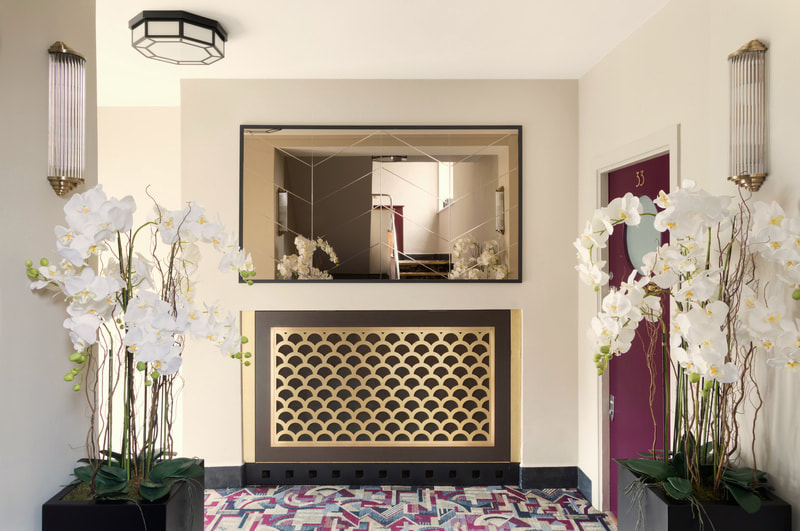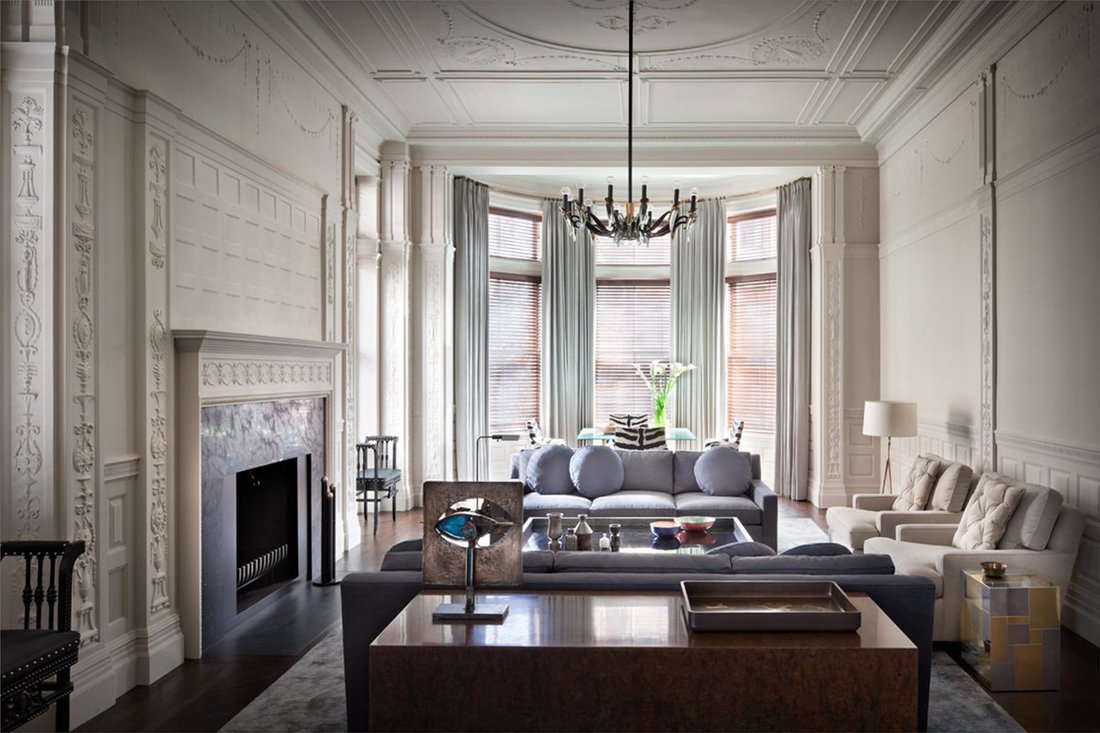|
The article below is an edited version of a piece featured in a members-only publication by the Institute of Residential Property Management (IRPM) as their ‘topic of the month’ in November 2018. For more information about the IRPM you can visit their website. An iconic grade II listed building designed by the architect Ernst Ludwig Freud has recently undergone a refurbishment to its common parts, bringing it back to its former glory. Designer Sam Bheda, who was commissioned by the RMC directors to oversee the design and redecoration works offers some insight into how block managers and residents can get the best out of their interior design – and their designer. Like many London blocks, the common parts hadn’t been redecorated for some time so they looked very dated - the walls had previously been rag-rolled in a peachy colour and the carpet looked tired. The interiors didn’t live up to the prestige of the building, so it was important to bring the block back to life by developing a scheme that would be sympathetic to the period architecture and at the same time inviting and comfortable for the residents. The vision for the project was to design a space that would re-capture the elegance of living in a 1930s apartment block. From a design perspective, this included developing the interior design concept, the colour palette and materials, the design direction, sourcing products from specialist suppliers as well as designing bespoke items. As far as redecoration projects go this was fairly complex with multiple parties involved, from the residents and block directors, to the professionals and specialist contractors and suppliers. All-in-all, the works took about a year but the end result has been very well received by the residents of the block. The financial investment is also paying off, with one local estate agent confirming that the flats have benefitted from an uplift in property values of approximately 5-7%. Regular communication to keep all parties informedOne of the difficulties with projects of this nature is the contradicting views from the various parties involved, so the consultation and planning stages are crucial. Initial meetings with key project stakeholders often present an opportunity to help shape the brief and to put forward ideas and suggestions that may not have been considered. In order to get buy-in from residents, it’s helpful to have a meeting at the early stages of a project where they can put forward their views about the improvements they would like to see to their block. Establishing a sub-committee to represent the views of residents, especially if it’s a large block, is also a good option. Open and transparent communication between all the parties and stakeholders involved is vital - residents should be kept informed at strategic points throughout the process and RMCs/other professionals must always be aware of progress at each stage, about any issues that come up, delays and so on. Planning ahead and establishing timescalesResidents should also have a clear understanding of what works are required and when they will need to take place. Planning ahead and being organised is essential because much of the design work will need to start first and will essentially inform the content of the s20 notices issued, estimates obtained from contractors and so on. An interior design project, from the initial researching and concepts through to sourcing and specifying, can take a long time so this should always be borne in mind. At key stages, consultation with residents and RMCs/directors will be required. If listed buildings consent is needed, the timings will need to allow for this. And with every project there will always be delays so building in some contingency is always advisable. Establish a realistic design and decoration budgetIt’s important to establish a realistic budget based on the scope of the project. The budget should be shaped based on an understanding of what the client requires from a design and decoration perspective. Involve the block manager from the outsetBlock managers also have a key role to play in getting buy-in from residents by ensuring their interior designer fulfils a few key tasks including:
If you are interested in finding out more about the project referred to in the above article, please get in touch.
0 Comments
You may not have thought about it, but our tastes in interior design and decor today are an evolution from prehistoric times. The actual profession of interior design is fairly new and has grown in popularity, particularly over the last century. The term ‘interior designer’ was first used in the 1930s and today’s interior designers navigate a host of specialist areas from spatial planning and lighting design to designing bespoke furniture and interior styling (the art of ‘dressing’ a space) for residential and commercial clients. However the origins of designing interiors can be traced back as far as the stone age where the interiors of prehistoric human dwellings featured drawings of plants, animals and humans. There is also evidence of cave paintings or ‘parietal art’ from as far back as 40,000 years ago, with animals being common subjects. Egyptians, Greeks and RomansIn Ancient Egypt during 2700BC to 30BC, royal families lived in elaborate buildings decorated with murals representing their history and incorporating basic furniture, vases and sculptures. In these early civilisations, interior design was a privilege of the ruling classes and the buildings not only signified their wealth, but were also intended to please their gods. This set a trend for ornate interior design in the name of religion. The Greeks and Romans made their mark from 1200BC to 480AD and had a profound influence on style, establishing the classical orders of architecture. Their interiors at the time featured ivory and silver, mosaics and bespoke furniture. Following this influential period many other styles emerged from byzantine to gothic and baroque to rococo. Some of the most notable styles are outlined below. Tudor style interiorsThis style emerged during an age of prosperity, which meant houses were lavishly built and decorated featuring oak panelling, plasterwork, stone fireplace surrounds and encaustic floor tiles. Bedrooms included carved wooden four poster beds, tapestries were hung to walls and rich velvet fabrics were the order of the day. Georgian periodThe Georgian era was know for its elegance, and the neo-classical style based on Greek and Roman ideas was one of the most enduring. Georgian interiors featured pastel colour schemes, classical columns, stonework, ironwork and marble. Motifs included swags, garlands and the greek key pattern as well as real and imaginary animal figures. Georgian periodThe Victorian era was noted for its bold prints and dark colours. Mass production enabled furniture and textiles to be acquired by home owners who decorated using flock and damask wallpapers, highly patterned fabrics and heavily carved furniture. Architectural features included decorative ironwork, ornate marble, stained glass and cast iron fireplaces inset with tiles. 20th CenturyThe early 20th century saw the modernist movement take hold, which was a reaction to the excessiveness of the past. The two most distinctive styles from this era were Art Deco and Modernism, which emphasised clean lines, simplicity of form, and the use of modern materials such as chrome, lacquer and inlaid woods. Interiors included innovative lighting, abstract patterns on carpets, fabrics and wallpapers and design motifs such as geometric shapes, stepped forms and chevron patterns. Interior design in the 21st CenturyToday’s interiors can best be described as transitional and contemporary, where designs take inspiration from different eras, architecture, art and travel. Whereas in the past, it was the cultural elite who had the wealth to transform their surroundings, mass production, the increase in home ownership following the second world war and globalisation have made home decoration accessible to the general population. The advent of media - from interior design magazines and home improvement television shows to social media such as Instagram and Pinterest - has brought greater awareness of interior design to the general public and people are decorating their homes to demonstrate their individual design tastes. Others, who are either time pressed, have specific design challenges or would simply like new ideas and alternative sources they may not otherwise consider are choosing to work with interior designers who can help them achieve the best results for their budget. Commercial and hospitality environments are also seeing an evolution in their interiors, whether it’s an office reception area that creates a positive first impression for clients or a restaurant that provides the right ambience and attracts a stylish crowd who appreciate luxe materials and carefully selected artwork, more and more businesses are seeing the benefits good interior design can bring. The future of the history of interior designThe history of interior design will continue to evolve in a globally connected world where our pace of life is faster and our lifestyles incorporate more technologies. Our design tastes are becoming more discerning, which is reflected in the wider use of unusual materials within interiors as well as the increased focus we place on the provenance of furniture and goods we buy. This is all balanced with a greater move towards more environmentally conscious design, the importance of sustainability and good design that lasts and stands the test of time.
|
ABOUTSam Bheda is an interior designer working on residential and commercial interiors in London, Suffolk and Cambridgeshire. CONNECTARCHIVES
November 2018
CATEGORIES
All
|


